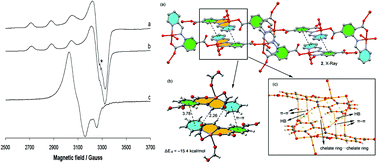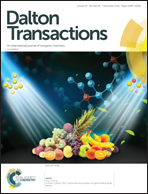Effect of temperature and ligand protonation on the electronic ground state in Cu(ii) polymers having unusual secondary interactions: a magnetic and catechol oxidase study†
Abstract
Two new copper(II) polymeric complexes, {[Cu(HPymat)(H2O)](NO3)}n (1) and [Cu2(Pymat)2(H2O)3]n (2), have been synthesized using the Schiff base ligand H2Pymat [H2Pymat = (E)-2-(1-(pyridin-2-yl)-methyleneamino)terephthalic acid]. Complex 1 is a cationic 1D polymer, whereas complex 2 is a two dimensional polymer. Both complexes were crystallographically, spectroscopically and magnetically characterized. Theoretical studies were performed and the catecholase activity of the complexes was also examined. Complex 1 is a ferromagnetically coupled complex with J = 2.8 cm−1 and 2 shows antiferromagnetic coupling with J = −1.6 cm−1. Both complexes show notable features in the EPR study. They show rhombic spectra at 77 K in the solid state, but by varying the temperature or solvents the nature of the spectra can be changed or inverted. This behaviour indicates a change of the ground state from dx2−y2 to dz2 orbitals. Theoretical calculations of 1 focus on the evaluation and characterization of interesting anion–π–anion assemblies that are formed in the solid state. In 2 we have analysed the unconventional chelate ring⋯chelate ring π-stacking interactions that govern its solid state architecture. Both complexes act as functional models and show catechol oxidase activity with a kcat value of the order of 103 h−1.



 Please wait while we load your content...
Please wait while we load your content...